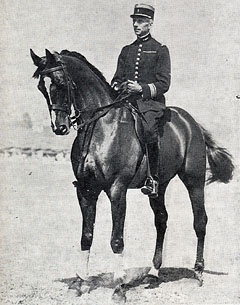
The shiny black Thoroughbred Taine became the 1932 Olympic gold medallist in Dressage. Eurodressage Greatest Oldies's readers are used to very extensive and detailed portrayals of the most successful or otherwise outstanding dressage horses of the past. This is only possible when we find live witnesses who are prepared to share their memories with us. With a horse which had its peak 80 years ago it seemed more than difficult to find out details and it became a jigsaw indeed.
Two times Silke Rottermann travelled to Saumur and visited the documentation centre of the Cadre Noir in France in the vain hope to find some photos and more information than the usual material provided in chronicles. She visited the places where Taine had lived and been trained for 14 years to get an impression.
Luckily she found enough to do a story, but had to rely on second-hand quotes and details from other stories. "I think this leggy thoroughbred, which became the first of only two horses of his breed so far to win the individual gold medal in Olympic dressage, makes a remarkable story," Rottermann told Eurodressage.
A different World of Dressage
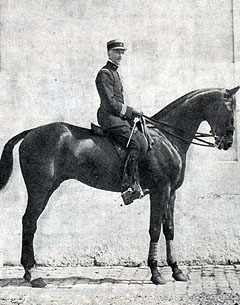 Even today one can feel the glory that once surrounded the legendary Ecole de Cavalerie with its bright buildings in the heart of the small Loire-town of Saumur in western France. For a horse and dressage lover who visits the historical Manège des Ecuyers it’s easy to imagine that so many decades ago a leggy narrow thoroughbred started its career as a dressage horse in this arena, where big French windows allow the sunshine to gracefully fall on steaming horses’ backs. It’s a place where one could think time stood still since the days dressage as a sport was in its infancy. Although it was an Olympic discipline for the first time in 1912 regulations and official FEI dressage competitions only evolved in late 1920s.
Even today one can feel the glory that once surrounded the legendary Ecole de Cavalerie with its bright buildings in the heart of the small Loire-town of Saumur in western France. For a horse and dressage lover who visits the historical Manège des Ecuyers it’s easy to imagine that so many decades ago a leggy narrow thoroughbred started its career as a dressage horse in this arena, where big French windows allow the sunshine to gracefully fall on steaming horses’ backs. It’s a place where one could think time stood still since the days dressage as a sport was in its infancy. Although it was an Olympic discipline for the first time in 1912 regulations and official FEI dressage competitions only evolved in late 1920s.
Unlike today dressage was a sport dominated by members of the military and on horses not specifically bred and selected for dressage, but to serve a military purpose. Whereas today a dressage rider is rarely successful without having the right horse power under the saddle other attributes counted 80 or 90 years ago. Much more than today the training and quality of a rider’s equitation decided victory and success.
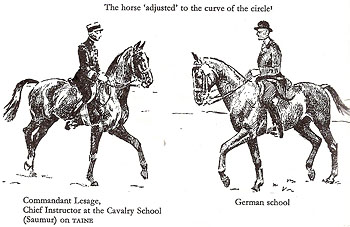 Rather few international dressage competitions were held between both World Wars and in them representatives of different schools representing different styles competed against each other. Whereas the German horses executed the programmes precisely, very obediently and with a rather strong bit contact, the French trained horses lacked the precision and were presented in a fairly open frame which often created the impression of the horse having some freedom while moving compared to the more strictly controlled German horses.
Rather few international dressage competitions were held between both World Wars and in them representatives of different schools representing different styles competed against each other. Whereas the German horses executed the programmes precisely, very obediently and with a rather strong bit contact, the French trained horses lacked the precision and were presented in a fairly open frame which often created the impression of the horse having some freedom while moving compared to the more strictly controlled German horses.
Until the creation of general dressage rules within the FEI the judges were more or less left alone with their decision which school to prefer and which to give top marks.
And even after the rules were valid from 1929 both schools, which aimed to assimilate the FEI rules, continued to exist in dressage.
In this comparatively young world of competition Taine can be considered as the first real star of this discipline, even though it was a long way to go from the green pastures of the Normandy to the Olympic coliseum in Los Angeles.
From the Green Pastures of the Normandy to the Mekka of the French Cavalry
Both in the USA and in France or other European countries it had been usual to choose thoroughbreds for the cavalry which had failed on the racetrack. As the budget of the acquisition commission was usually not unlimited cheap suitable horses were more than welcome. So it might not be surprising that a young thoroughbred was among the horses chosen by the French cavalry to be brought to Saumur to start a life as a cavalry horse. In Taine’s case a great career as a steeplechaser first seemed much more in store than the strict world between A and C.
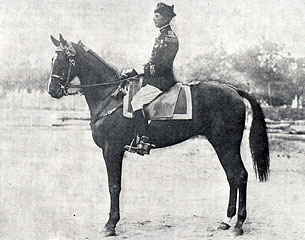 This beautiful black was bred by André Chédeville and born in 1922 at the French thoroughbred stud Haras du Petit Tellier in Normandy. The facility still is to date one of France’s leading studs for thoroughbreds. Both Taine’s parents were successful racehorses in France,but their careers suffered from World War I. Taine’s sire Mazzara raced and also did steeplechasing from 1914 to 1918, earning several wins and high placings on the most renowned French race courses. His dam Truffe, also bred by Haras du Petit Tellier, was raced as well, but later on became the personal riding horse of Taine’s breeder. She was said to have owned the outstanding natural balance and smoothness which later made Taine so extraordinary as a dressage horse.
This beautiful black was bred by André Chédeville and born in 1922 at the French thoroughbred stud Haras du Petit Tellier in Normandy. The facility still is to date one of France’s leading studs for thoroughbreds. Both Taine’s parents were successful racehorses in France,but their careers suffered from World War I. Taine’s sire Mazzara raced and also did steeplechasing from 1914 to 1918, earning several wins and high placings on the most renowned French race courses. His dam Truffe, also bred by Haras du Petit Tellier, was raced as well, but later on became the personal riding horse of Taine’s breeder. She was said to have owned the outstanding natural balance and smoothness which later made Taine so extraordinary as a dressage horse.
Like most other thoroughbreds destined to excel on the flat or over hurdles Taine’s youth on the lush green fields of the beautiful stud was cut very short and as a yearling he was sold to become a racehorse. Unfortunately the big gelding, which looked extremely noble, did not become what he was bred for and instead was suggested to the acquisition commission of the French army which was looking for suitable horses every year. They happily agreed taking on Taine who was transported to Saumur where at that time more than 1,000 horses of the army were stabled in the huge Ecole de Cavalerie. On the day of his arrival at the stable, which would become his home until his death, he was given to Captain Robert Wallon, a two-time Olympic dressage rider for France, to be trained for military duties.
A Thoroughbred’s Transformation into a Dressage Horse
It’s not reported if Taine was destined to become a dressage horse chasing for glory for the tricolore from the beginning. Fact is that during those times with competitions on international level evolving the écuyers of the Cadre Noir concentrated on training Grand Prix dressage. All their horses had to undergo the usual military training at the beginning of their time and it was no different with Taine who turned out to be not the easiest horses to train, physically and mentally.
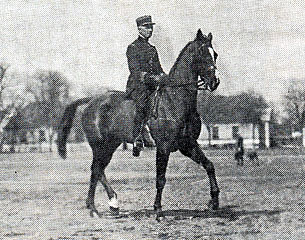 He was described as a most pleasant model with a very expressive head and a high set topline which made it easy to elevate him and which gave him a noble look.
He was described as a most pleasant model with a very expressive head and a high set topline which made it easy to elevate him and which gave him a noble look.
Taine was a long-legged horse with narrow, long cannon bones and fetlocks standing high above the ground. His back was long and his hind legs quite straight with slightly curved knees, which altogether made dressage work a real challenge. His riders reported that the sensitive thoroughbred was moreover a very feisty and alert horse which was always wide-awake. With him one had to be delicate and make compromises to succeed and move a step forward.
Wallon started the gelding and presented him successfully as a young horse in his first dressage competitions. In 1928 Taine and Wallon appeared in the limelight for the first time and won in Paris. Colonel Xavier Lesage, an accomplished Olympic dressage rider, took him over when Taine was already a horse able to show the Grand Prix movements. While Taine's long striding canter and trot were fine and full of graciousness Taine had to make efforts with the movements that demanded a great extent of lowering of the haunches, in particular the piaffe.
His long straight hind legs and the fact that he at least looked a bit croup high didn’t help either. Whereas Taine found the flying changes incredibly easy and executed them with such naturalness that one couldn’t detect any human influence, he really struggled with a solid piaffe at the beginning. As a thoroughbred his conformation was far from ideal to easily lower the haunches. Apart from that during that time the French approach was clearly influenced by the 2nd method of Francois Baucher, so the submission was tried to obtain by the so called “mise en main”, the relaxation of the mouth and poll instead of the German submission aimed that the horse gives in the neck.
It was said that not the piaffe, but the walk had been the thoroughbred’s major flaw. He only possessed a short walk which tended to become irregular in the extensions. On the other hand the overall picture this horse gave from the beginning of his career, one expressing natural gracefulness and a rarely seen nobility, was outstanding and distinguished him from many of his rivals which back then were of the sturdier type. When Lesage, who had already won Olympic bronze on Plumarol in 1924, took the horse the main aim was to improve Taine's flaws before starting him again.
 During that time Colonel Danloux was the écuyer-en-chef at the Cadre Noir and responsible for the training of the new pair. Danloux, himself a 1928 Olympic dressage rider, was as a brilliant rider and trainer. He was a stern and meticulous teacher from the ground, spending long hours in the Manège des Ecuyers or in one of the many outdoor arenas to support the similarly gifted Lesage in his daily attempt advancing Taine to the highest levels. Lesage first major job with Taine was work on the contact. The horse tended to move in a wrong neck position which made the correct flexion of the poll in collection impossible. Once the right elevation was achieved Taine moved with elegance and Lesage could start improving the walk, piaffe and passage.
During that time Colonel Danloux was the écuyer-en-chef at the Cadre Noir and responsible for the training of the new pair. Danloux, himself a 1928 Olympic dressage rider, was as a brilliant rider and trainer. He was a stern and meticulous teacher from the ground, spending long hours in the Manège des Ecuyers or in one of the many outdoor arenas to support the similarly gifted Lesage in his daily attempt advancing Taine to the highest levels. Lesage first major job with Taine was work on the contact. The horse tended to move in a wrong neck position which made the correct flexion of the poll in collection impossible. Once the right elevation was achieved Taine moved with elegance and Lesage could start improving the walk, piaffe and passage.
This sounds easier said than done because Taine was an individual and one of the kind which was delicate to treat. Lesage described him as a hot-tempered character who was rather spooky and at first not too amiable. It needed quite some diplomacy to bring the self-willed horse on his side. His patient feeling worked in Lesage’s favour later on in the competitions. He reported that Taine’s alertness made the halts at the beginning of each ride easier as the horse was always fascinated by the judges’ table. Taine froze, his heart beating extremely.
The hard and dedicated work paid off when the new combination started for the first time together and won the important competition in Paris before he went on to compete at the 1931 FEI championships in dressage in Vichy. These championships had been held by the FEI since 1927 and were the most important dressage competitions in between two Olympic Games. Official European and World championships were only held from the 1960s on.
At Vichy Taine and Xavier Lesage faced competition from just 6 other riders from two more nations. It was a rather disappointing number of starters because the FEI championships a year before had attracted 11 riders from 7 different nations. The performance they displayed was of such brilliance that it gave the competition the meaning it deserved. It was the first time the wider dressage public witnessed the French duo expressing extraordinary elegance, something dressage is intended to do: Give the horse the natural gracefulness back it once owned without somebody in the saddle. Holy words for many who tried and still try hard, but never succeed. Taine had inherited great natural balance and smoothness of movements his mother was famous for and together with the unison he had reached with his new rider Taine gave the impression of doing everything on his own, as if he was born to do Grand Prix.
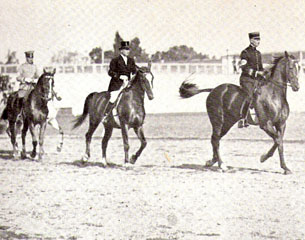 The French approach of dressage suited the sensitive and proud horse well and produced the excellence which the stricter German approach was hardly able to reach. Deeply impressed by the kind of dressage he saw at Vichy the legendary German Baron von Langen, Germany’s first Olympic dressage champion in 1928, made clear that the true art of riding is not limited to a specific approach. For him Lesage’s fine riding style and the beauty of Taine’s movements were proof that real horsemanship doesn’t know any borders. As the possibilities of foreign starts were limited compared to today Taine’s second competition abroad in 1931 was at Pardubice in the Czech Republic. The Cadre Noir sent its best combinations to the east of Europe to face strong opposition from some of the best German riders, among them Felix Bürkner on his excellent thoroughbred Caracalla xx, which was a member of the victorious German team at the 1928 Olympics in Holland.
The French approach of dressage suited the sensitive and proud horse well and produced the excellence which the stricter German approach was hardly able to reach. Deeply impressed by the kind of dressage he saw at Vichy the legendary German Baron von Langen, Germany’s first Olympic dressage champion in 1928, made clear that the true art of riding is not limited to a specific approach. For him Lesage’s fine riding style and the beauty of Taine’s movements were proof that real horsemanship doesn’t know any borders. As the possibilities of foreign starts were limited compared to today Taine’s second competition abroad in 1931 was at Pardubice in the Czech Republic. The Cadre Noir sent its best combinations to the east of Europe to face strong opposition from some of the best German riders, among them Felix Bürkner on his excellent thoroughbred Caracalla xx, which was a member of the victorious German team at the 1928 Olympics in Holland.
Bürkner described in his biography “Ein Reiterleben” that the sight of Lesage training Taine before the competition was overwhelmingly beautiful and set hearts aflutter as make them sink regarding the German chances for success. Still Caracalla xx managed to beat Taine, who came 2nd in the Grand Prix (back then called “Olympic programme”) against riders from Germany, Austria and the Czech Republic.
After their convincing outings at home and abroad in their first year of competition the next logical goal in the pair’s career had to be the 1932 Olympic Games, but for the first time since horses were involved in the Games, the modern Olympics were held outside Europe, in the Californian town of Los Angeles.
What still today requires some careful planning, logistics and a lot of money, was an adventure back then which several European countries not even able to make because they lacked the financial resources during the global financial crisis which had swept from the US to Europe in 1929.
A Long Journey to Olympic Glory
France was among the three European countries which during the Great Depression were able to fund the incredibly long trip over the Atlantic. Flying was much in its infancy and non-existent for horses, so all athletes had to do the long journey from Europe to the USA by ship.
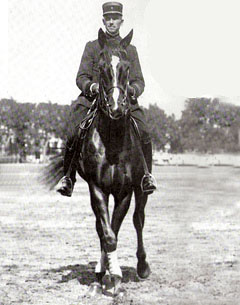 The Olympic dressage competitions which in the previous 1928 Amsterdam Olympics had attracted 29 riders from 12 nations suffered seriously from European nations which refrained to make the effort travelling to the other end of the world. For dressage only Sweden and France went on the gruelling trip to be joined in Los Angeles by the USA and Mexico.
The Olympic dressage competitions which in the previous 1928 Amsterdam Olympics had attracted 29 riders from 12 nations suffered seriously from European nations which refrained to make the effort travelling to the other end of the world. For dressage only Sweden and France went on the gruelling trip to be joined in Los Angeles by the USA and Mexico.
France sent only a team of dressage horses, among them Taine, André Jousseaume’s Sorelta and the very experienced and highly successful Linon ridden by Commandant Pierre Marion, the 1928 Olympic silver medalist and winner of the 1930 FEI dressage championships in Lucerne. The 1928 Olympic dressage horse Clough- Bank, another thoroughbred, boarded as the reserve horse which could easily have been needed in such circumstances.
The French horses were shipped to the East coast and from there travelled across the American continent to its destination on the west coast. The sea crossing lasted weeks but luckily for the horses it was uneventful. It is not reported in which way the French kept their horses moving, but the Dutch became famous exercising their victorious eventers on a kind of treadmill on the ship to keep them fit. Of course it was unthinkable to train horses in a reasonable way on the ship and even after the horses felt US soil under their hooves they were just reloaded onto a train to continue their journey.
Finally the French team arrived at its destination and moved in the stables near the Santa Monica golf club where nearby polo fields provided excellent possibilities to exercise the horses after the journey. They could stretch their legs and relax their minds.
Soon after their arrival some newspapers reported that the French team had landed for its Olympic start and many visitors strolled to the stables to look at the horses. Colonel Lesage reported that Taine needed some time to trust the foreigner, but he was then showered with sugar lumps.
Olympic Greatness
When the day of the competition came there were some novelties: Thanks to extensive media coverage beforehand the equestrian event almost sold out! More than 25,000 spectators attended the dressage competition held on the polo field of the Riviera Country Club.
 The programme to be ridden was 16 minutes long and for the first time included piaffe and passage. A transition from passage to extended trot and two between piaffe and passage were asked. The piaffe had to be between ten and twenty steps. Other movements were 10 serpentines in canter, of which 5 had to be in counter-canter, 4, 3, 2 and one tempi changes. There were no complete pirouettes, but half-pirouettes in walk as well as in canter. Moreover the riders had to show a diagonal in extended trot and one in medium canter with a one-handed flying change at X. It is interesting to note that it was allowed the horses to be either slightly bend on the circle or to be comparatively straight, depending to which “school” (German or French) they belonged to.
The programme to be ridden was 16 minutes long and for the first time included piaffe and passage. A transition from passage to extended trot and two between piaffe and passage were asked. The piaffe had to be between ten and twenty steps. Other movements were 10 serpentines in canter, of which 5 had to be in counter-canter, 4, 3, 2 and one tempi changes. There were no complete pirouettes, but half-pirouettes in walk as well as in canter. Moreover the riders had to show a diagonal in extended trot and one in medium canter with a one-handed flying change at X. It is interesting to note that it was allowed the horses to be either slightly bend on the circle or to be comparatively straight, depending to which “school” (German or French) they belonged to.
The first two French riders did extremely well and Lesage and Taine had enough time to warm up. Lesage stressed that he put his focus on relaxing and calming down his sensitive thoroughbred which was successful. Lesage confessed later that he didn’t know which heart had beaten faster when they entered the arena: his own or Taine’s which he felt beating through his boots. Still Taine put in a faultless performance in his usual brilliant style and it seemed obvious that either he or his stable mate Linon would lead and become the individual gold medalist and France the team champion.
However, the points awarded by the three judges from the USA, Sweden and France were not made public promptly due to an incidence regarding the Swedish rider Bertil Sandström. This two-time Olympic silver medalist had shown a high class ride which would have brought him a third silver medal, but an unofficial sideline judge claimed the Swede had clicked his tongue in the piaffe which was forbidden by the FEI. The discussions on that incidence delayed Taine’s result and ended with the decision to put Sandström last in the individual placings, but keep his high marks for the team competition, earning Sweden the silver.
The French team as well as Taine took the gold medal in a superior way, though it took some time to bring the great message back home to France. Some journalists had mixed up Sandström’s name with Lesage’s and reported on the radio Lesage would have been disqualified. The greater the joy was when to correct news was published about the two gold and one silver medal of the French team.
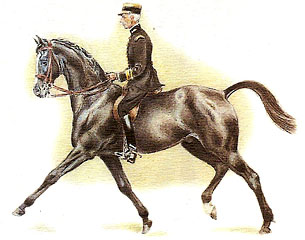 Unlike with the other participants the three judges were fairly in unison regarding Taine. Of course the French judge Lafont, Commandant of Saumur had put him in 1st place, but also Doak from the US placed him 2nd and Bonde from Sweden 3rd. The judges were not that close with the other horses. It left a bitter taste though that all judges put a representative from their own country first.
Unlike with the other participants the three judges were fairly in unison regarding Taine. Of course the French judge Lafont, Commandant of Saumur had put him in 1st place, but also Doak from the US placed him 2nd and Bonde from Sweden 3rd. The judges were not that close with the other horses. It left a bitter taste though that all judges put a representative from their own country first.
For Lesage and Taine the real challenge and biggest highlight of their career came a bit later. As the victorious rider he got the honour to ride the Grand Prix reprise again in the Olympic main stadium in Los Angeles in front of more than 100,000 spectators before the opening ceremony. A unique honour to this very day which required from his rider limitless faith in his highly sensitive horse. Every rider can only guess what it must have been like to enter such an incredibly huge stadium like the Coliseum through a dark tunnel, being alone in the calm dark for some metres and then join a mass under the bright Californian sunshine.
Like in the competition itself the horse managed to focus on his rider for more than 16 minutes to show the Grand Prix once more. It was proof of a great partnership, proof of the excellent training of Taine over the years. With the slightest of bit contact, sometimes a non- existing one, a self-carriage rarely seen in today’s dressage anymore, and mane flying Taine had the performance of a life-time. One of the best representatives the Cadre Noir has ever had excelled a last time before returning home to Saumur, more than 10,000 kilometres from the location of his Olympic triumph.
A Victim of the War
Taine arrived back home unscathed and continued his career for one more year as a celebrated hero of the equestrian world. In Paris he showed his Olympic programme under the watchful eyes of president Albert Lebrun in the Grand Palais and repeated it in Belgium for King Albert I. Afterwards he delighted the Swiss crowds in Geneva once more.
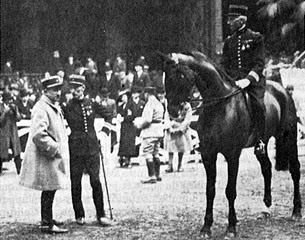 This last appearances in the spotlight led to a quieter life in Saumur where Taine lived until he was an 18-year-old. Like many other famous dressage horses the outbreak of World War II a year earlier had threatened Taine’s life. When the Germans entered France the country was split in occupied and free zones. In 1940 the horses of Saumur were intended to be evacuated to a free zone in France. Amongst these horses was also the most famous one of the Ecole de Cavalerie, but unfortunately Taine had never been an easy horse to load. He had the habit to hold his head high above the entrance of a wagon and so one had to put a blanket over his head to lower it. This bad habit should mean the end of Taine’s eventful life when the evacuation took place in 1940. When he was loaded by a rider who didn’t know the horse very well Taine defended himself and unfortunately broke his leg. There was nothing left to do than shoot this dressage legend on the spot.
This last appearances in the spotlight led to a quieter life in Saumur where Taine lived until he was an 18-year-old. Like many other famous dressage horses the outbreak of World War II a year earlier had threatened Taine’s life. When the Germans entered France the country was split in occupied and free zones. In 1940 the horses of Saumur were intended to be evacuated to a free zone in France. Amongst these horses was also the most famous one of the Ecole de Cavalerie, but unfortunately Taine had never been an easy horse to load. He had the habit to hold his head high above the entrance of a wagon and so one had to put a blanket over his head to lower it. This bad habit should mean the end of Taine’s eventful life when the evacuation took place in 1940. When he was loaded by a rider who didn’t know the horse very well Taine defended himself and unfortunately broke his leg. There was nothing left to do than shoot this dressage legend on the spot.
Taine’s end might be one of the saddest of a great dressage horse, but compared to the misery and hardship so many war horses had to endure in the years to come his ending was at least quick.
Colonel Lesage who went on to become the Cadre Noir’s écuyer-en-chef had no chance to say goodbye to his best horse and companion of many years. Instead he got one of Taine’s hooves sent by mail which he kept as a sad memory to his friend.
There have been so many great dressage horses, every single one brilliant in its own way, but there have only been two thoroughbred horses, Taine and Juli, which captured Olympic gold. The way Taine did it was unique as he created the impression he was the gifted dressage horse moving that naturally in the most difficult movements as if a horse in freedom.
by Silke Rottermann for Eurodressage
Acknowledgement
Ecuyer Patrice Franchet d’Espèrey for recommending suitable literature and supporting my researches at the Documentation Centre of the Ecole Nationale d’Equitation in Saumur.
References
- Max E. Ammann, The FEI championships, The history of the World, Continental and Regional FEI Championships, Lausanne 2007, p. 31 + 326.
- Felix Bürkner, Ein Reiterleben, Verden 1957, p. 211 + 251.
- Colonel Challan Belval, Le colonel Lesage, unknown, p. 10-12.
- Général Decarpentry, Jacques Perrier, Le colonel Lesage, in : Les Maitres Ecuyers du Manège de Saumur, 1993, p. 119-121.
- Jean Froissard, Les Jeux d’hier, 1932 Los Angeles, Période faste pour le dressage francais + Vingt-deux mouvements pour une épreuve, published in : L’Eperon ½ 1984, p. 85/86.
- Raymond Madec, Un nom prestigieux du manège de Saumur : Taine, published in : Les Amis du
- Cadre Noir, Bulletin d’Information no. 22, July 1986, p. 26-31.
- Jacques Perrier, L’Age d’or du manège, in : L’Épopée du Cadre Noir de Saumur, 1992, p. 67-79.
- Général Rethore, Le colonel Xavier Lesage, published in : L’Eperon 10/11 1968.
http://rha.revues.org/index633.html: Général Pierre Durand, L’Age d’or, in : Cadre Noir.